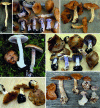The largest type study of Agaricales species to date: bringing identification and nomenclature of Phlegmacium (Cortinarius) into the DNA era
- PMID: 25737596
- PMCID: PMC4312940
- DOI: 10.3767/003158514X684681
The largest type study of Agaricales species to date: bringing identification and nomenclature of Phlegmacium (Cortinarius) into the DNA era
Abstract
Cortinarius is a species-rich and morphologically challenging genus with a cosmopolitan distribution. Many names have not been used consistently and in some instances the same species has been described two or more times under separate names. This study focuses on subg. Phlegmacium as traditionally defined and includes species from boreal and temperate areas of the northern hemisphere. Our goals for this project were to: i) study type material to determine which species already have been described; ii) stabilize the use of Friesian and other older names by choosing a neo- or epitype; iii) describe new species that were discovered during the process of studying specimens; and iv) establish an accurate ITS barcoding database for Phlegmacium species. A total of 236 types representing 154 species were studied. Of these 114 species are described only once whereas 40 species had one ore more synonyms. Of the names studied only 61 were currently represented in GenBank. Neotypes are proposed for 21 species, and epitypes are designated for three species. In addition, 20 new species are described and six new combinations made. As a consequence ITS barcodes for 175 Cortinarius species are released.
Keywords: Basidiomycota; DNA barcoding; ITS; diversity; taxonomy; typification.
Figures












References
-
- Abarenkov K, Nilsson RH, Larsson K-H, et al. 2010 The UNITE database for molecular identification of fungi – recent updates and future perspectives. New Phytologist 186, 2: 281–285. - PubMed
-
- Ammirati JF. 1972. The section Dermocybe of Cortinarius in North America. PhD thesis, University of Michigan, USA.
-
- Ammirati JF, Hughes KW, Liimatainen K, et al. 2013. Cortinarius hesleri from eastern North America and related species from Europe and western North America. Botany 91: 91–98.
-
- Bidaud A, Moënne-Loccoz P, Carteret X, et al. 2005 Atlas des Cortinaires. Pars XV. Èditions Fèdération mycologique Dauphiné-Savoie, France.
-
- Bidaud A, Moënne-Loccoz P, Reumaux P. 1992. Atlas des Cortinaires. Pars IV. Èditions Fèdération mycologique Dauphiné-Savoie, France.
LinkOut - more resources
Full Text Sources
Other Literature Sources
Molecular Biology Databases
Research Materials
